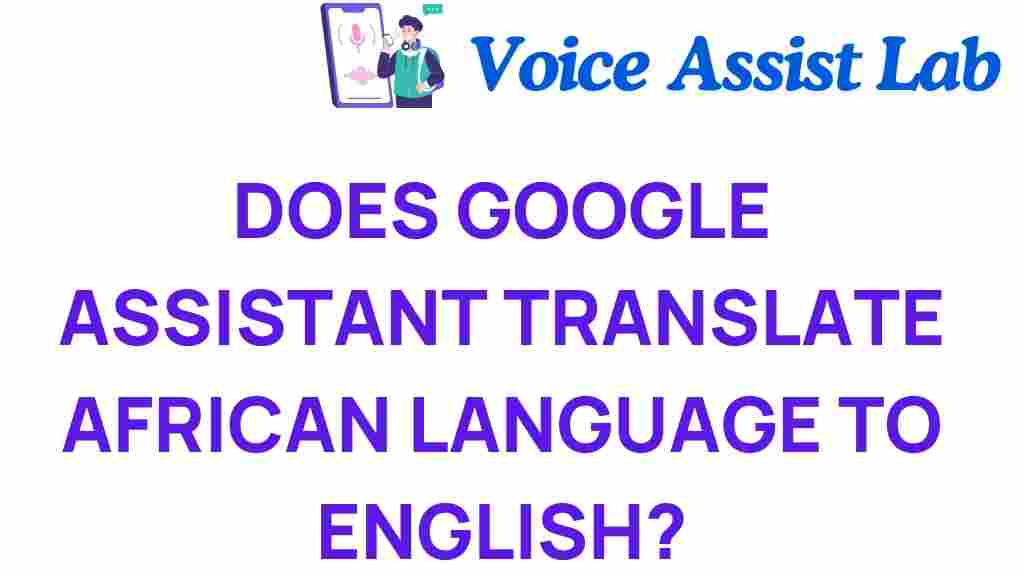Can Google Assistant Bridge the Language Gap for African Speakers?
In an increasingly interconnected world, effective communication is vital. For many African speakers, language barriers can pose significant challenges in everyday interactions, education, and access to information. With the advent of technology, tools like Google Assistant are emerging as potential solutions to bridge these gaps. This article explores how Google Assistant can aid in language translation, enhance communication for speakers of African languages, and facilitate a more inclusive digital landscape.
Understanding the Language Landscape in Africa
Africa is home to over 2,000 distinct languages, making it one of the most linguistically diverse regions in the world. While languages such as Swahili, Arabic, and Hausa are widely spoken, many local dialects remain underrepresented in digital spaces. This linguistic diversity can hinder access to information and technology.
- Multilingualism: Many Africans grow up speaking multiple languages, which can complicate communication.
- Technology Adoption: The rapid growth of mobile technology in Africa has not always kept pace with the need for multilingual support.
- Accessibility Issues: Language barriers can limit access to essential services, education, and job opportunities.
How Google Assistant Works for Language Translation
Google Assistant leverages advanced voice recognition and language translation technologies to facilitate communication across different languages. Here’s how it works:
- Voice Activation: Users can activate Google Assistant by voice commands, making it accessible for those who may not be proficient in typing.
- Real-Time Translation: Once activated, users can speak in their native language, and Google Assistant translates it into the desired language in real time.
- Multilingual Support: Google Assistant can understand and respond in multiple languages, allowing for seamless switching between languages during conversations.
Bridging the Communication Gap
The potential of Google Assistant to bridge communication gaps for African speakers is significant. Here are some key areas where this technology can make a difference:
- Education: Students can use Google Assistant to access educational resources in their preferred languages, making learning more inclusive.
- Healthcare: Patients can communicate with healthcare providers without language barriers, ensuring better understanding and care.
- Business: Entrepreneurs can engage with global markets by overcoming language obstacles, broadening their reach and opportunities.
Step-by-Step Process to Use Google Assistant for Language Translation
Using Google Assistant for language translation is straightforward. Follow this step-by-step guide:
- Set Up Google Assistant: Ensure that you have Google Assistant installed on your device. You can download it from the Google Play Store for Android devices or access it through iOS.
- Choose Your Languages: Go to the settings of Google Assistant and select the languages you want to use. You can choose your native language and a second language for translation.
- Activate Voice Recognition: Use the voice command “Hey Google” to activate the Assistant.
- Start Conversing: Begin speaking in your native language, followed by the phrase “Translate to [desired language].” For example, “Translate to English.” Google Assistant will then translate your speech.
Troubleshooting Common Issues
While using Google Assistant can significantly enhance communication, users may encounter some issues. Here are some troubleshooting tips:
- Voice Recognition Problems: If Google Assistant struggles to understand your voice, try speaking clearly and at a steady pace. Ensure that your device’s microphone is not obstructed.
- Language Not Supported: If your language is not recognized, check if Google has added support for your language. You can report this through the Google feedback option.
- Connection Issues: Ensure that your device is connected to a stable internet connection, as Google Assistant requires online access for real-time translation.
Innovations in Language Translation Technology
The field of language translation technology is evolving rapidly. Innovations are making tools like Google Assistant even more effective for African languages. Key advancements include:
- Machine Learning: Improved algorithms help Google Assistant learn and adapt to different accents and dialects.
- Contextual Understanding: Enhanced contextual recognition allows for more accurate translations based on the conversation’s context.
- Expanded Language Support: Ongoing efforts to include more African languages in Google’s translation services.
Accessibility and Inclusion
One of the most significant benefits of using Google Assistant for language translation is its potential to enhance accessibility. By providing support for African languages, it can help:
- Empower Local Communities: Giving voice to those who may have been marginalized due to language barriers.
- Enhance Digital Literacy: Encouraging more people to engage with technology, as they can navigate in their native languages.
- Foster Economic Growth: Improving access to information can lead to better job opportunities and economic development.
Conclusion: The Future of Communication in Africa
As we look ahead, the role of technology in bridging language gaps for African speakers cannot be overstated. Google Assistant stands at the forefront of this innovation, offering tools and resources that can transform communication and accessibility. By enabling effective language translation and supporting multilingual interactions, Google Assistant has the potential to create a more inclusive digital environment for everyone.
As technology continues to advance, it is crucial that developers focus on expanding support for African languages and making these tools accessible to all. The future of communication in Africa is bright, and with innovations like Google Assistant, the language gap can be bridged, paving the way for a more connected and informed society.
For more insights on technology and communication, check out our latest articles on digital innovation.
This article is in the category Innovations and created by VoiceAssistLab Team
